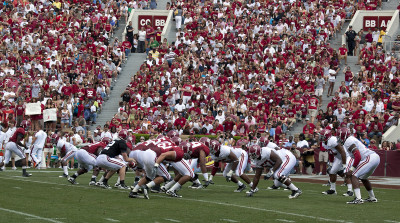
Since 2006, the Southeastern Conference has dominated the college football spectrum by winning seven national championships in the past nine years. However, with the resurgence of the Big Ten Conference’s seemingly unstoppable Ohio State University the past few seasons and the steady fall of major programs like the University of Alabama and Auburn University, it looks as if the SEC’s time at the top of the mountain has come to an abrupt end.
Since the hiring of head coach Urban Meyer in 2012, the Buckeyes have gone an astonishing 42-3 and won a national championship last season. Recruiting at OSU has definitely been an important factor to its dominance, as it has not one, not two, but three fantastic options at starting quarterback. Braxton Miller, who now plays both wide receiver and running back for the Buckeyes, J.T. Barrett and Cardale Jones all have spent time under center in the past two seasons.
While Barrett and Jones were thrust into the spotlight due to injuries, they both responded by playing the quarterback position at an elite level and were major factors in Ohio State’s drive to the title last season.
Another program that has been making noise in the Big Ten is Michigan State University. Head coach Mark Dantonio and company have put together a pretty impressive resume in the past two seasons, boasting 13-1 and 11-2 records, respectively. In those two double-digit win seasons, the Spartans have won both the Cotton Bowl in 2014 and the Rose Bowl and the Big Ten Conference Championship in 2013.
The Spartans’ Cotton Bowl victory came in a shootout against Baylor University in which they won 42-41 after storming back from a 20-point deficit in the fourth quarter. This year Michigan State sits in the No. 2 overall spot in the Associated Press’ Top 25, just below fellow Big Ten member Ohio State. The two Midwestern giants square off on Nov. 21 in Columbus, Ohio.
The future of the Big Ten looked significantly brighter when the University of Michigan hired former San Francisco 49ers head coach Jim Harbaugh during the offseason. The Wolverines have been absent from the college football elite since 2012, when first-year head coach Brady Hoke led Big Blue to a Sugar Bowl victory over Virginia Tech.
After three subsequent years of mediocrity, the school with the most wins in college football history dumped Hoke and brought in Harbaugh, a UM alum, to take over the struggling program. Recruiting has soared under Harbaugh’s watch, and it appears as if the Wolverines are trending in the right direction. They are ranked No. 22 after blanking Brigham Young University last week by a score of 31-0.
In the SEC reside perennial superpowers Alabama, Auburn, Louisiana State University, the University of Mississippi, the University of Florida and the University of Georgia. While the conference is made up of 14 total teams throughout the southern region of the United States, those six teams, with the intermittent success of Texas A&M University and Mississippi State University, that usually dominate all of college football.
Auburn and Florida used to be in the national championship hunt seemingly every year, but recently have fallen off the map. Florida’s last time in the title game was when Meyer directed its 2009 national championship win over the University of Oklahoma.
Since Meyer’s departure for ESPN and then eventually Ohio State, the Gators have looked lost and have struggled to remain relevant. As for Auburn, they were featured in the national championship just two years ago when they lost to Jameis Winston and Florida State University by a score of 34-31. Ever since the loss to FSU head coach Jimbo Fisher’s squad, the Tigers have gone a mediocre 10-7.
In recent years, Georgia and Ole Miss have started off hot in the beginning of the season. Last year, Ole Miss won its first seven games in a row and vaulted up to No. 3 in the country. Georgia followed suit by winning six of its first seven tilts and found itself at No. 8 overall.
Similarly, this year, the Rebels are once again ranked No. 3 after upsetting Alabama and then steamrolling Vanderbilt University, while the Bulldogs sit at No. 8 as they prepare to take on the crumbling Crimson Tide.
Both teams have a history of starting strong but ultimately falling apart at the end of the year, as evident by Ole Miss losing four out of its last six games and Georgia’s defeats to an unranked Florida team and rival No. 16 Georgia Tech in 2014. This season may prove to be different for both squads, as their schedules look easier than those of prior years. But until the Rebels and the Bulldogs prove they can hang with the big boys, neither team is elite yet.
LSU is ranked No. 9, but looked lackluster against a lower-tier Syracuse University team. The Tigers only managed to beat the Orange by 10 points and will quickly fall out of contention if they continue to trend downward. While I’m certain LSU will bounce back in a big way against Eastern Michigan University, ending its season by playing three top-15 opponents does not bode well for LSU head coach Les Miles.
This finally brings us to the peculiar case of the Crimson Tide. Over the past five seasons, Alabama has been favored in 72 straight games. In 2014, when Alabama lost to eventual national champions Ohio State in the Sugar Bowl, the Crimson Tide averaged 484.5 yards of total offense per game
Those mammoth numbers under Lane Kiffin’s offense are impressive to say the least, which brings us to this question: why is Nick Saban’s squad currently 3-1 and No. 13 overall if they are perennial super powers? Largely, it is because of the departures of running back T.J. Yeldon, quarterback Blake Sims and Heisman finalist Amari Cooper. While the Tide are usually very good at replacing their stars once they bolt for the NFL, this year seems to be a down one for the fans in Tuscaloosa.
A big test for Alabama, which has won three national titles since 2009, will come Saturday as they take on Georgia at Sanford Stadium in Athens. If Alabama cannot overcome the Bulldogs, it might spell the beginning of the end of its FBS dominance.
The simple fact is that the Big Ten is climbing to the prominence it once knew in college football, while the SEC heads towards a level just south of elite. But, with the new College Football Playoff in effect, there is always room for any team to make some noise.


At no point during this blog did you come remotely close to a coherent thought. We are all dumber from having read this. You are awarded no points, and may God have mercy on your soul.